Bogatyr class armoured cruisers (1900)
 Russian Empire 1899-1936: Bogatyr, Oleg, Kagul, Ochakov, Vityaz
Russian Empire 1899-1936: Bogatyr, Oleg, Kagul, Ochakov, Vityaz
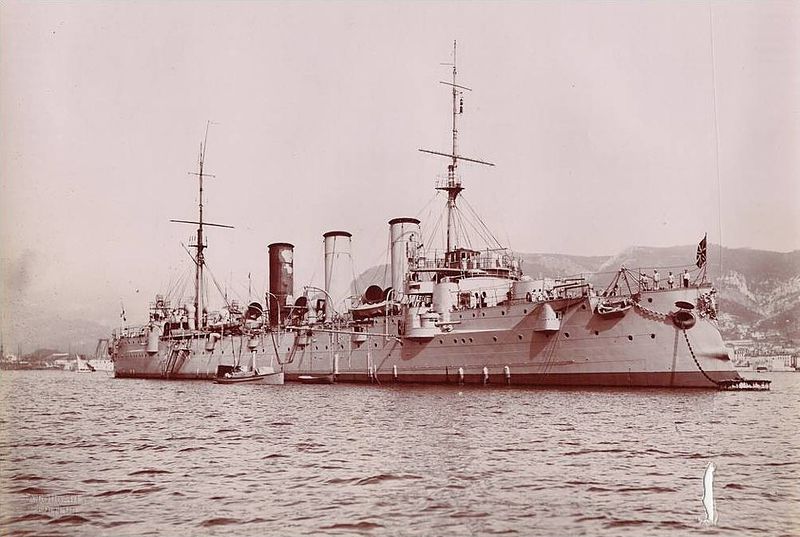
A new class for Russian Protected Cruisers: The Bogatyr class were armored cruisers of the Russian Imperial Navy, classified as 1st rank, with five planned and built. The project was developed under supervision of the Vulkan Yard design team, which also built the lead cruiser Bogatyr. Three next were built in Russia (Oleg, Kagul, Ochakov) in local yard however the fifth, Vityaz, burnt under construction and was cancelled. They experienced various fates between the Russo-Japanese war and WWI. Two took part as expected in the Russo-Japanese war. Bogatyr took refuge in Helsinki and ended scrapped in Germany (logically…), Vityaz burned in her slipway, Oleg was torpedoed by British CMBs in Kronstadt in 1919, Ochakov became Kagul, Kornilov, scrapped in 1933 in the USSR while Kagul became Pamiat Merkuria, fought against the Goeben, became the TS Komintern and was destroyed by the Luftwaffe during the siege of Leningrad…
Origins and development
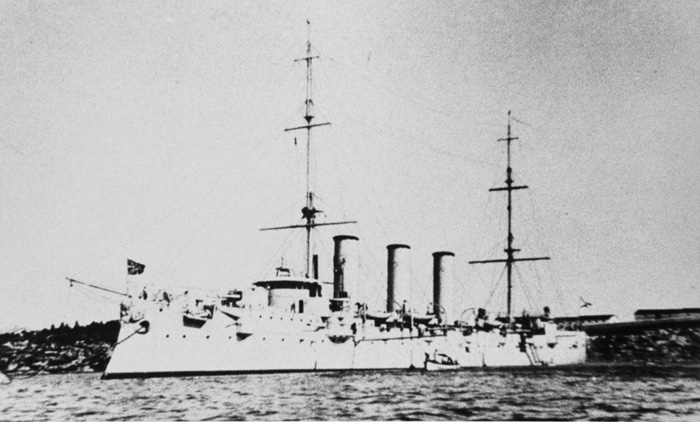
Pamiat Merkurya
On December 27, 1897, a special meeting of the Russian fleet admiralty board was held by the Admiral General. Its object was to follow new trends in development and programs of the Navy, and the meeting notably recommended concentrating on the Pacific Ocean, having in 1903, in teh recently aquired Port Arthur, ideally a fleet of ten squadron battleships, five armored cruisers, ten armored cruisers of 5,000-6,000 tons of displacement plus ten “scout-armored cruisers” of 2,000-2,500 displacement. The latter were intended as long-range reconnaissance cruisers for the squadron had to not only conduct reconnaissance, but also took part in squadron action or work independently on enemy trade (the Royal Navy was targeted). Needless to say this was the most ambitious program of Imperial Russia ever, and it was only partially realized (and shattered in the Russo-Japanese war).
Since Russian Yards would not suffice for this colossal endavour, foreign yards were also soon contacted, in all countries.
Varyag became the first cruiser ordered under the 1898 naval program.
On February 20, 1898, Nicholas II approved the “special shipbuilding program for the needs of the Far East”. Which also integrated the 1895 program, and supposed to include six cruisers with a 5,000-6,000 tons displacement range. Immediately after it, Naval Minister P.P. Tyrtov instructed the Marine Technical Committee (MTC) to develop a design for this new serie, ideally of the same class, and all built in Russia.
Developing requirements for this long-range reconnaissance cruiser called for greater speed, yet better protection than similar cruisers of the Japanese and British fleets (In alliance by 1902). Japanese armored cruisers of the Kasagi class for example were considered as their most likely foe. The project was developed as an answer to the Takasago built for the IJN by Vickers Armstrong. Kasagi and her sistership Chitose were built however in the USA and displaced 4,760-4,900 tons, 6,000 FL and were capable of a 22.5 knots, armed with two 203-mm guns, ten 120-mm. They were considered the best armored cruisers of the Japanese fleet, and the Russian cruisers were supposed to surpass them.
According to this stringent assignment, the new cruisers were to reach 23 knots, have at least 5,000 miles range at 10-knot, use Belleville water-tube boilers and be armed by twelve 152-mm French Canet guns (built by Obukhov) believing capable to deliver as larger, faster broadside. 203 mm guns were considered by the Russians too heavy and slow for cruisers and 120 mm too light, so the 6-in caliber was deemed a good balance. In addition a light armamament against TBs of twelve 75-mm guns as well as eight 47-mm guns was suggested, and also six torpedo tubes notably for close squadron combat and trade warfare.

yakumo
For economical reasons however displacement was limited 6,000 tons, which given the parameters for speed, range and armament excluded a good armor belt. Therefore, the it was considered only an armored deck without specifying thickness. The armored deck was to be complemented by side coal pits and cofferdams, but the rest was completely ignored. Thus the “armored” cruisers were likely more protected.
Design Process and Construction planning
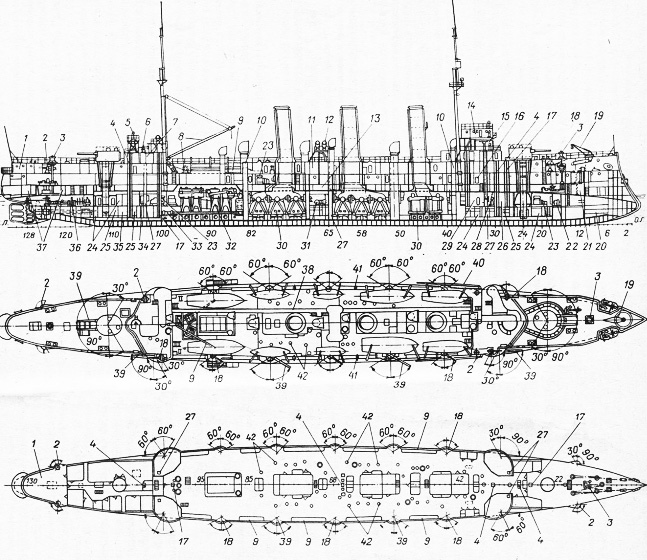
Despite certain successes in domestic shipbuilding, the capacities of Russian shipyards and factories at the time turned out to be insufficient to meet the urgent needs of the fleet. Therefore, in 1898 it was decided to transfer part of the orders for warships under the 1898 program to foreign companies on a competitive basis. Among them were three long-range reconnaissance cruisers. At the same time, the capacities of the domestic industry were not sufficiently used as recoignised and a balanced was looked after.
Competition
The design program setup great haste were sent to both Russian and foreign Yards in April 1898. Conditions were determined on of the specified characteristics were met and construction time no to exceed 28 months and at a cost of 4 million rubles.
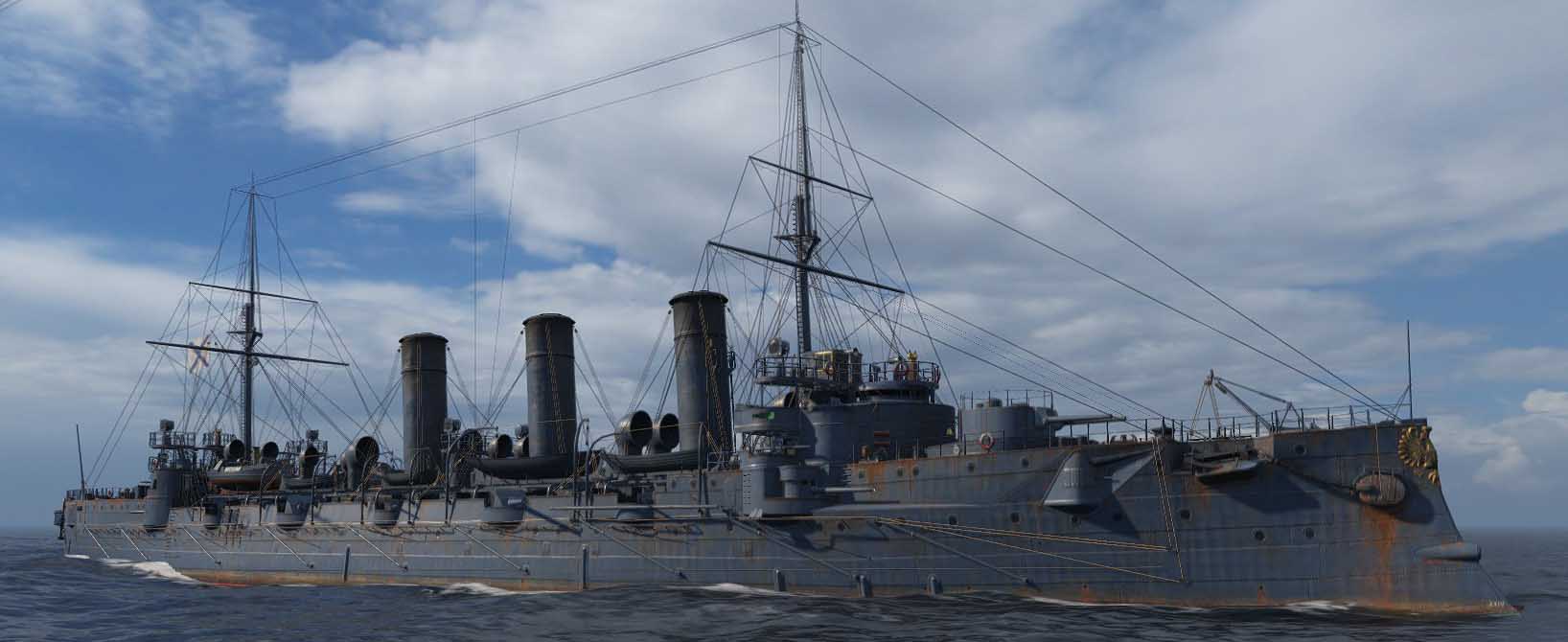
The Naval Ministry’s tender commission started final discussion without waiting for the receipt of all projects and five companies were chosen in an informal “first round”: Nevsky Yard, Ansaldo, Germaniawerft, Schichau and Hovaldtswerke. Although the Schihau project was recognized the best in terms of firepower and protection, the commission considered that Germaniawerft design, backed-up by Krupp, had the bast balance within the allotted displacement. A decision was made on July 3, 1898. On July 27, 1898, Nicholas II gave permission to order the lead ship. On August 4, 1898, a contract was signed with Germaniawerft for the construction of “Askold”, first ship of the class.
In addition, without any competition on April 11, 1898, a contract was signed with the New York shipbuilder Cramp for another cruiser with a displacement of 6,000 tons, the future “Varyag“. The latter yard was not even submitted a draft design and simply suggested by the Russian Naval Ministry to take the Kasagi, also previously built by the same company, as a prototype.
Vulkan’s proposal
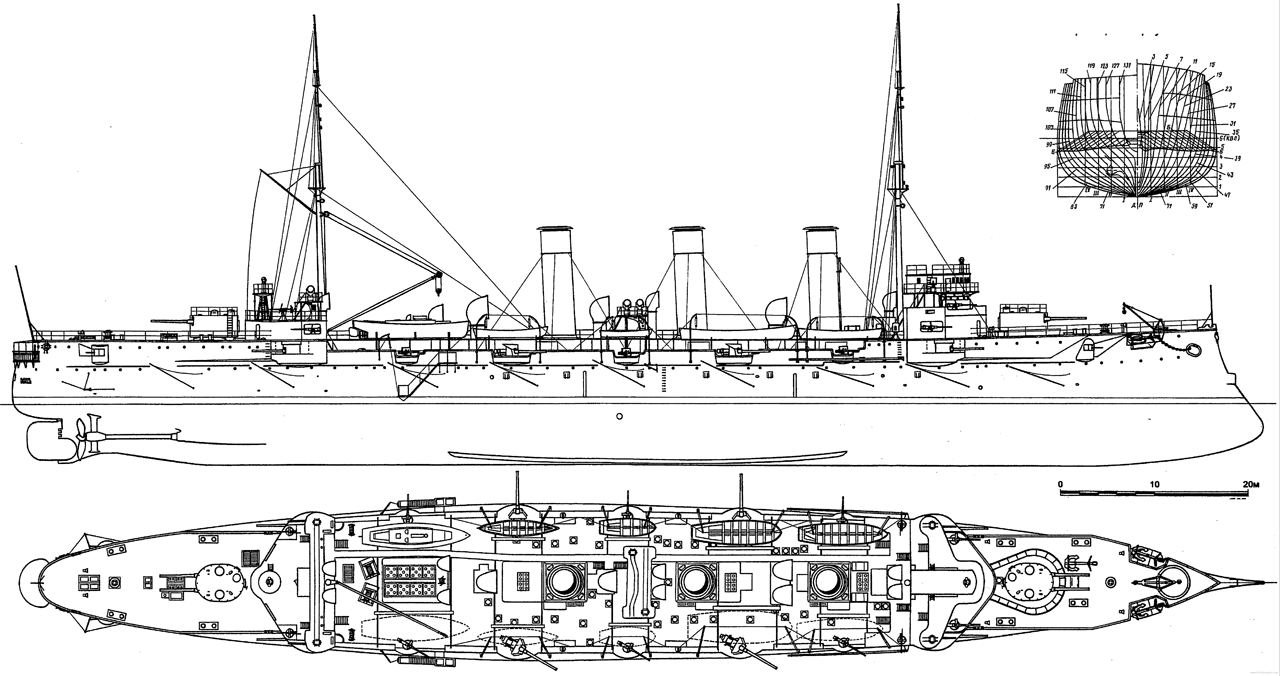
On July 20, 1898, despite the first round was over, German Yard Vulkan presented its own project, which proposal arrived later. It appeared to the commission as a scaled-down “Yakumo” already built by the same yard. Comparing this project with the winner of the competition, the Russian commission came to the conclusion that the offer looked even more attractive. Especially significant was the noticeably stronger armor protection and presence of thickened longitudinal bulkheads.
The design was very reminiscent of the Yakumo and looked like indeed the same in reduction, but its more limited displacement did not allow for the installation of an armor belt and forced to significantly weaken both the artillery and its protection. The requirement for 23 knots led to the installation of more powerful machinery, obliged to decrease the beam for a more favourable ratio, and thus abandon extra internal compartimentation, notably double ends. As a result, there were some reservations but by August 4, 1898, a contract was signed for the construction of the lead cruiser, and Germaniawerft was informed of this. Immediately Vulkan answered it would deliver the ship wihtin 24 months, without taking into account approval of specifications and drawings. However, and most importantly, an agreement was reached on the transfer to Russia of all technical documentation in order to organize construction of sister ships in domestic shipyards. The first agreement was not adequately written and needed a new agreement later with Vulkan to be signed by the fall of 1899 for the transfer of documentation on an additional fee.
The technical project was submitted to the commission on October 4, 1898, which added 110 comments and suggestions for Vulkan. The question of boilers was especially important. Russian specialists insisted on Belleville boilers, which had proven themselves in the Russian fleet, but the Germans insisted on installing lighter and more compact Normand boilers. Despite Russian objections, Vice-Admiral F.K. Avelan, which temporarily managed the Naval Ministry, approved Vulkan’s proposal. Finalization of the project went on until the end of the year, even after construction of Bogatyr started in Stettin.
Hull and general design
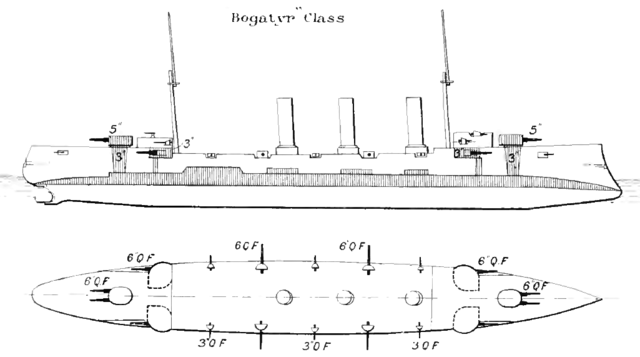
Hull construction
The Bogatyr-class cruisers were three-funneled, two-masted ships with a forecastle and poop. The hull was rivet-assembled (1,823,000 rivets) using a bracket system from steel sheets and profiles. The vertical keel was watertight throughout the double bottom and hard cast extremities. A stem with a ram was installed at the bow plus sternpost. Five reinforcement frames were installed on both sides of the keel, six in the engine room area. Frames were spaced by just one meters between them. Steel sheets were attached to this set, overlapping horizontally and back to back vertically.
Internaly the hull was divided into three metal decks laid on beams. The interdeck height was 1.98 m. The upper deck was covered with teak, and the rest with linoleum.
The hull was painted three times outside and inside, while underwater part was also covered with a special compound to protect against corrosion and fouling. Total mass of the hull with armor was 3,490 tons and the hull cost alone was estimated at 2,532,510 rubles. The hull measured 134 m (439 ft 8 in) long for 16.6 m (54 ft 6 in) in beam and with a 6.3 m (20 ft 8 in) draught.
Superstructures

The superstructures were, as customary for the time, reduced to the minimum. There was some sort of bulwark forward to protect the forecastle’s tertiary battery, with the conning tower built at the middle. A platform with all navigation and command devices as well as the forewheel were installed above. It was left for completion to the Russians with a wooden bridge, which had another open deck on its roof.
The foremast was located aft of it, composed of three stages and designed to carry sails as specified. They were never installed though; The aft mast was identitical, also without fighting or spotting tops. Only different was a boom for the service of two steam cutters installed on deck. In the intermediate space amidship were located the three slightly raked funnels, six gooseneck main intakes and two secondary eitehr side, plus access and ventilation hatches all along. There was a walkway running across the whole space connecting the forecastle and poop. The artillery was protected behind bulwarks all along the battery deck.
Crew and accomodations
The crew officially included 2 staff officers, captains of 1st and 2nd ranks or CO-XO, 11 chief officers, midshipmen and lieutenants, 4 mechanical engineer, 6 medics and battalion supply officers, 1 senior boatswain and 7 conductors as well as 551 non-commissioned officers and sailors but it varied between cruisers and over time. Officers were accommodated in single and double cabins and had a common wardroom. The commanders had their own rooms at the stern, suites with bedroom, saloon, dining room office plus dedicated staff. The commander had his own wine cellar and his messenger had a separate cabin. At night, hammock beds were hung in the “living deck” right below the main deck and adjacent or in the lower battery deck. Hammockes during the day were placed in bed nets. They had hanging tables and some civilian employees could be used for procuring and preparing food, as for Oleg in the Second Pacific Squadron there were a restaurateur and officer’s cook.
Armour protection layout
-The armored deck constituted the main protection with its caracteristic turtleback, with an horizontal 75 cm (29 in) above the waterline, but lowered downards to 34°, 135 cm (53 in) below the waterline. The deck dropped to the bow and stern and armor plates laid on a waterproof steel jacket, bolted. The deck armor used extra-soft nickel steel from the Izhora plant which on impact rather formed a depression than shatter.
-Side walls covering the raised part of the deck above the engine room, being 85 mm thick (33 in).
-The boiler casings and funnel crowns were 30 mm thick (11 in).
-The forward Conning tower, rather large with separe roof and excellent visibility was 140 mm thick (55 in)
-The the froward structure protecting guns was 100 mm thick (39)
-The main pipe encasing cables and drives from the wheelhouse to the central post was 70 mm (27 in).
-The turrets vertical walls were 125 mm (50 in) with a 90 mm roof (35 in)
-The barbette was between 73 (28 in) and 51 mm (20 in) below the armored deck
-The Ammunition supply elevators were protected by 35 mm walls (14 in)
-The battery deck gun shields were 25 mm thick (10 in).
For ASW protection these crisers had 16 watertight bulkheads dividin the hull below waterline into 17 watertight compartments. Cofferdams were arranged along the side at the waterline level. They were supposed to be filled with cellulose (The french way), but negative reviews about this forced them to end with empty cofferdams doubling as additional Coal pits, which were also located at the sides, bove and below the armored deck.
Powerplant
All the Bogatyr class had two shafts, ending with three-blade bronze propellers 4,900 mm in diameter with a pitch of 5,700 mm and it was possible to change propeller pitch by installing other blades. These were driven by two four-cylinder triple expansion engine each with a nominal 9,750 shaft horsepower.
In turn they were fed by sixteen small-tube Normand boilers, all coal-fired, with a total heating surface of 4600 m², generating steam with a working pressure of 18 atm. They belonged to the triangular type, with tubes of small diameter and were located in three boiler rooms at the the bow (four, with fireboxes along the way), middle and aft section with 6 boilers each with fireboxes to the side, hence the three funnels.
The power plant consisted was calculated to provide 23 knots (43 km/h). For range, these ships carried 1,220 tons of coal, with 280 tons fresh water for the boilers. Estimated range was 4,900 miles at 10 knots. They also had four steam generators producing a 105 volts current located in one compartment on the lead ship, Bogatyr, but in two for the other ships, with two in each, for more safety. They helped the ship powering notablt weaponry in case the ship was “cold”.
Armament
Almost all these ships had a French origin artillery produced in Russia under license. In 1892, specialists from the artillery department concluded it was better to switch to lightweight guns and shells, to increase initial velocity, increase flatness and accuracy at short and medium distances. This also was expected to save on gun and shell cost. As a result, Russian shells became lighter with the 1892 152 mm (6-in) 55.4 kg shell going down to only 41.4 kg for a 11.7% less cost. They were made thicker with lesser explosive warhead of 3.5% of the mass or lower, almost SAP shells. They used Brink fuses which were later found unreliable, and produced a lot of duds. With hindsight, these decisions were found completely erroneous and the Bogatyr were not very efficient as a result.
Main
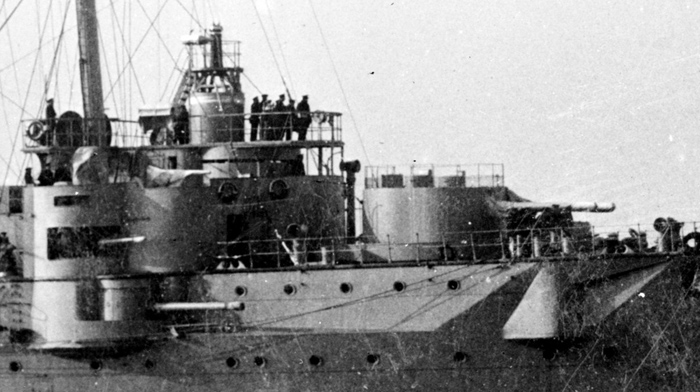
152-mm gun were of the Canet (Russified as “Kane”) type as main caliber, designed in France by Gustav Canet. They made an excellent impression on the Russian military delegation in 1891 which brought a license in 1892 to be produced by Obukhoff.
It was possible to achieve a rate of fire of up to 10 rounds per minute, which was impressive for this caliber, but this was on paper, as in practice it went down to 6-7. Using a “unitary cartridge” type was not practical between weight and size, so separate loading was the norm since 1901. The gun were considered quite modern at the time, but the Russo-Japanese showed some shortcomings in its weak lifting mechanism and arches or knurlers when used intensively with excessives schocks and vribration resulting of impacts. In short, too tight tolerances were the culprit.
In total twelve of these 152-mm guns were carried, in two twin turrets fore and aft, the remainder in single shielded mounts located on the main open battery deck. The ammunition stock was 180 rounds per barrel or 2,160 shells in total. Four were in semi-enclosed casemates also fore and aft. Distribution ensured four in chase and retreat, and eight in broadsides. On paper this was superior to the Varyag and Askold, quite an argument in favor of a large production, but this turned out to be untrue in combat.
The turrets were of the French type, rounded with vertical walls and a domed roof made by Metal Works, with electric with manual backup drive. In practice, they turned out to be too cramped, slow and unreliable as well as jamming easily. With intensive firing the concentration of powder gases reached a dangerous level which forced to stop, causing the rate of fire to drop to just 3 rounds per minute per barrel or even less. In addition, their guidance was separate from the rest of the main artillery, complicating centralized fire control. In the end, they proved a hinderance, as many officers argued that the choice of a pair of open mounts like on Varyag would have been a much better choice.
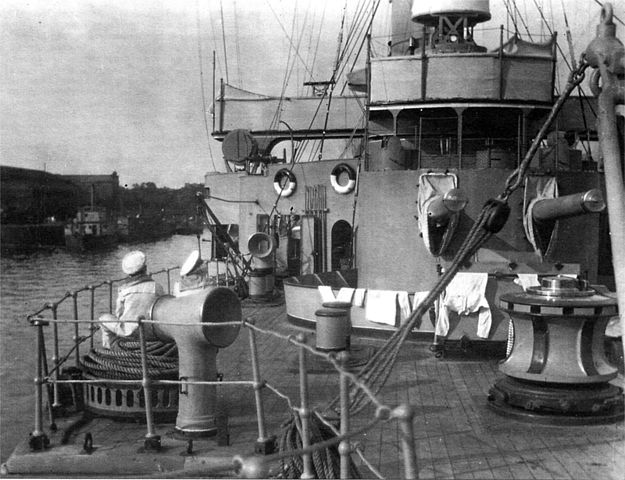
Secondary
After the 6-in, the cruiser’s secondaries went directly to the 75-mm caliber (3-in), also Canet guns under licence. 12 were installed on the upper deck, forecastle, poop and bridge. They were interspersed with the main guns on the battery guns and this made them difficult to control. They were tasked to fight enemy destroyers but realities of combat clearly showed they were too small and short range to effectively hit destroyers which in between considerably have grown in size. They also only fired armor-piercing shells, which often simply went through and holed these destroyers rather than causing real damage.
Torpedoes and Mines
Torpedoes emerged as a dubious use new weapon in the late 19th century they were seen a necessary for self-defense and finish off badly damaged enemy ships. The original project planned four torpedo tubes, two on surface and two underwater but only Bogatyr had them. For the rest it was reduced to the two underwater torpedo tubes, installed in a special compartment under the armored deck. These were “Whitehead self-propelled mines” in the official deocumentation of the time, Model 1898 which were 381 mm (15 in) in caliber for 5.18 m in lenght, 430 kg and carrying a 64 kg warhead filled with pyroxylin. Range had two settings, 550 m at 28.5 knots or 915 m at 25 knots which was not impressive when compared to the “Long Lance” to say the least. It shows the progresses made in about 20 years in this field. From a last resort “coup de grace” weapon to a real offensive one.
Modifications
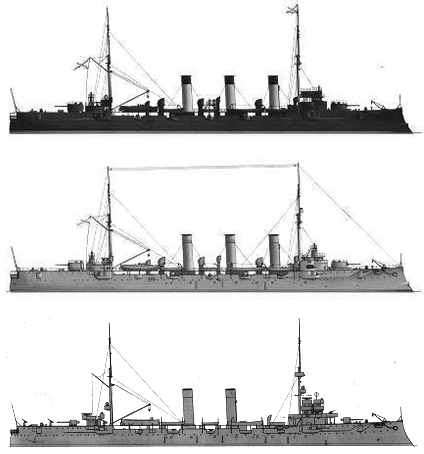
In 1908, Oleg saw the removal of five 37mm/17 Hotchkiss guns.
By 1911 Bogatyr had the same but also her two bow and stern 381 mm TTs and by 1912 Pamiat Merkuriya and Kagul had eight 47mm/40 and all their 37mm/17 guns also removed. The same in 1914 saw the removal of the remaining twelve 75mm/48 guns in exhange of the addition of four more 152mm/44 Canet guns and two 75mm/48 Canet AA guns.
By 1916 Bogatyr saw the removal of two 152mm/44 Canet guns, eight 152mm/44, and all her remaining 75mm/48 plus eight 47mm/40 guns, in exchange for two twin 130mm/53 fore and aft and twelve single 130mm/53 and mine rails to carry 150 mines. Oleg undertook the same, but with differences: She also received two single 75mm/48 Canet AA guns and two 47mm/40 Hotchkiss AA guns.
In 1917 Kagul saw the removal of two 152mm/44 guns and all remaining ones for the addition in turn of ten modern 130mm/53 guns.
In 1923, Komintern was completely refitted, first with two twin 152mm/44, twelve 152mm/44 and two 75mm/48 removed in exchanged for siwteen 130mm/53 and two single 47mm/40 Hotchkiss AA guns.
In 1931 she was turned into a training ship with four boilers removed to make room for classrooms and accomodations for cadets (top speed 12kts). Armament-wise, she received six single 130mm/53, two 47mm/40 guns and four single 76mm/28 8K. Then WW2 broke out and she was further modified, more radically.
By early 1941 her fore funnel was removed and two main guns removed as well as a single 76mm/28 guns in exchage for an AA battery with three 45mm/43 21K guns and five 12.7mm/79 HMG plus new rail for mines (195). In the summer, during Operation Barbarossa, she received two single 25mm/70 72K AA guns and early in 1942, lost three remaining 76/28mm guns for the addition of three 76mm/52 34K guns, sampling the AA guns aboard modern Soviet ships. This was not enough however. Attacked thrice she was eventually sunk by the Luftwaffe.

⚙ specifications |
|
| Displacement | 6,500 long tons (6,604 t) |
| Dimensions | 129.6 x 15.8 x 6.3 m (425 ft 2 in x 51 ft 10 in x 20 ft 8 in) |
| Propulsion | 2 shafts VTE, 30 Niclausse boilers 20,000 ihp (15,000 kW) |
| Speed | 23 knots (43 km/h; 26 mph) |
| Range | 6,100 miles |
| Armament | 12× 152mm, 12× 75mm, 8× 47mm, 2× 37 mm, 6× 381 mm TTs |
| Protection | See notes |
| Crew | 570 |
Career of the Bogatyr class cruisers (1902-1937)
 Bogatyr
Bogatyr
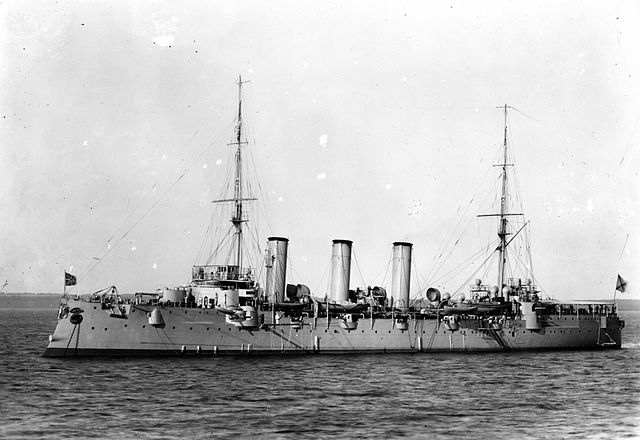
The cruiser Bogatyr was laid down at Vulkan, Stettin on December 9, 1899, although construction started earlier , but was hampered by numerous design revisions by the Russian committe. She was launched on January 17, 1901 and by November 1901, started machinery tests, with final delivery delayed by the Russian manufactured turrets and artillery. Final acceptance trials took place only in June 1902 in the Danzig Bay, showing a max speed of 23.55 knots. Later German Emperor Wilhelm II came aboard and was impressed, calling her the best ship ever built for the Russian fleet. On September 24, 1902 she arrived in Kronstadt to be pressed on the Baltic Fleet.
But on November 13, 1902 she departed for the Far East as shakedown cruise, soon overloaded with extra coal, under command of Rear Admiral E. A. Shtakelberg. Unlike the rest of the fleet she showed excellent performances overall. On May 9, 1903 she arrived in Port Arthur in perfect condition in the First Pacific Squadron. On September 24, 1903 she left Port Arthur as part of the Vladivostok detachment making three campaigns in January-April 1904 to disrupt Japanese communications (as intended), but results were poor. On May 2, 1904, Rear Admiral K. P. Jessen sent Bogatyr to Posiet Bay. The fog caused her to ran aground at Cape Bruce. A month was needed to save her, and by June 1, 1904, she was towed back and sent to Vladivostok for repairs but it turned out to be difficult and was intermit for more than a year. Eventually Bogatyr returned into service on September 5, 1905, after war.
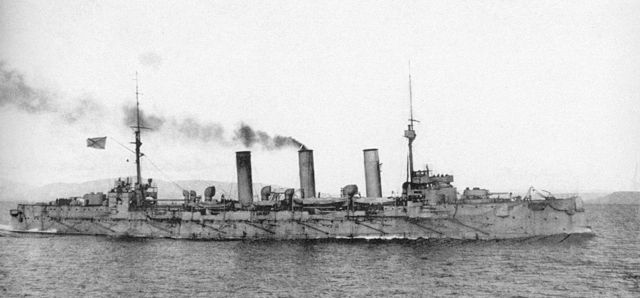
After further repairs, Bogatyr was sent to the Russian Baltic Fleet and deployed in the Mediterranean to assist the populations after the large earthquake in Sicily on 28 December 1908, notably at Messina with some sailors killed by aftershocks during attemps tof pulling trapped inhabitants under rubble. In 1912, Bogatyr she had a complete refit at Kronstadt. WWI saw her pressed into the 1st Cruiser Brigade of the Baltic Sea. On 26 August 1914 with Pallada she captured SMS Magdeburg off Osmussaar (Estonia). Although the latter was scuttled LtCdr Habenicht was captured as the all important German code book. In 1915, Bogatyr covered minelaying operations and some of her own mines co-claimed SMS Augsburg off Bornholm.
On 2 July 1915 she took part in the Battle of Åland Islands seeing the loss and capture of SMS Albatross. In late 1915 she had another refit in Kronstadt receiving new 130 mm/55 B7 Pattern 1913 guns. In 1916 she also operated off the coasts of Finland and Sweden, preying on German convoys.
After the November Revolution, she joined the Red Navy and after the armistice of December she was demobilized at Helsinki. Brest-Litovsk forced her out to Kronstadt (‘Ice Voyage’) placed into reserve until 1922, later scrapped in Germany.

 Vityaz
Vityaz
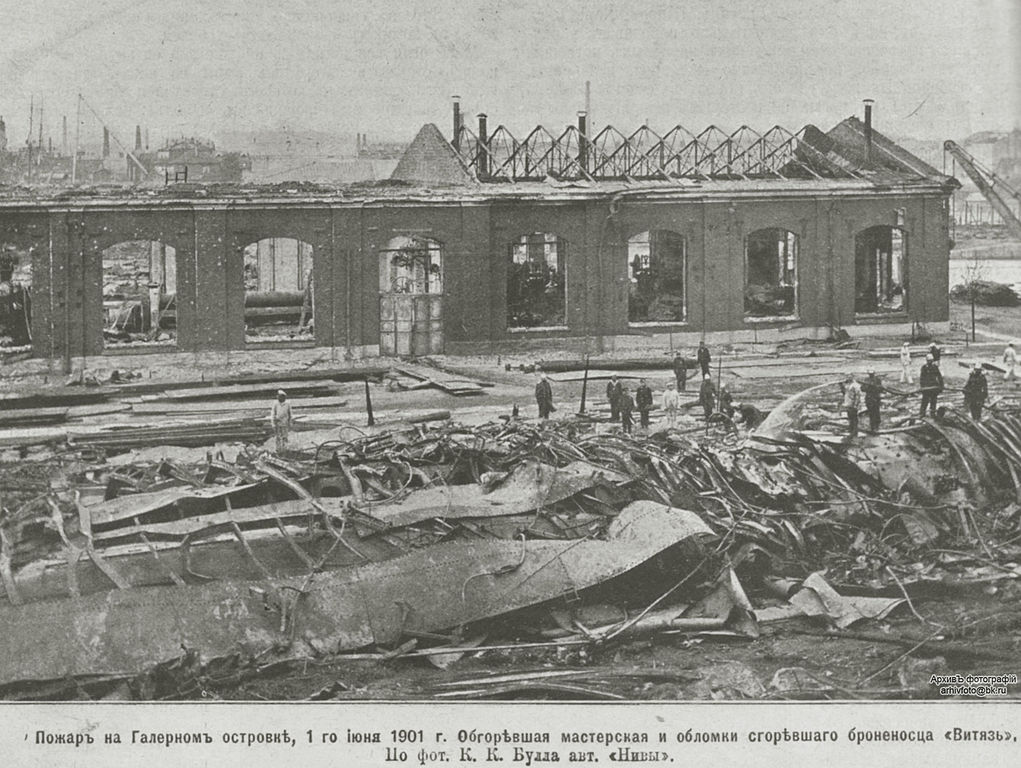
Vityaz destroyed on slip, in 1901
“Knight” was to be the first Bogatyr-class cruiser built in Russia, in the Admiralty Galerny Island Yard (A. I. Mustafin), for the Baltic Fleet, ordered by January 9, 1900. Translation of drawings from the metric system into Russian and agreesing to Vulcan’s corrections made the construction proeed slowly and final drawings were only received by September 1900. Main parameters were recalculated to 6,781 tons, 400 more originally thought. She was laid down by October 21, 1900, and by January 1, 1901, 3% advanced. She was named “Vityaz” officially later on April 21, 1901. On May 4, 1901, she was ready for launched, which was done on May 23, with the participation of Grand Duke Alexei Alexandrovich. By June 1, 1901 she was 10% reay when a fire broke out in the wooden shed nearby on June 1, 1901.
The cause of the fire was due to poor fire safety rules, started in the forge located at the bow. The workers used coking coal, when the forge overturned and fell down, covering the wooden scaffolding with burning coke and soon the fire engulfed the entire ship in 10 minutes while workers fled in panic. All fire departments in St. Petersburg were scrambled but arrived too late. Vityaz’s hull had been burned out, with metal parts half melt or bended. In fact only the battleship in construction nearby was saved. Along with the cruiser, the boathouse No.2 and other buildings all burned, making one victim, a riveter trapped inside the double bottom section and cooked alive in the hull. The damage was evaluated to 1,100 thousand rubles. On June 14, 1901 she was officially stricken and the metal parts dismounted, sent to the foundry to be recast. The equipment planned for her went to her sister Oleg.
 Oleg
Oleg
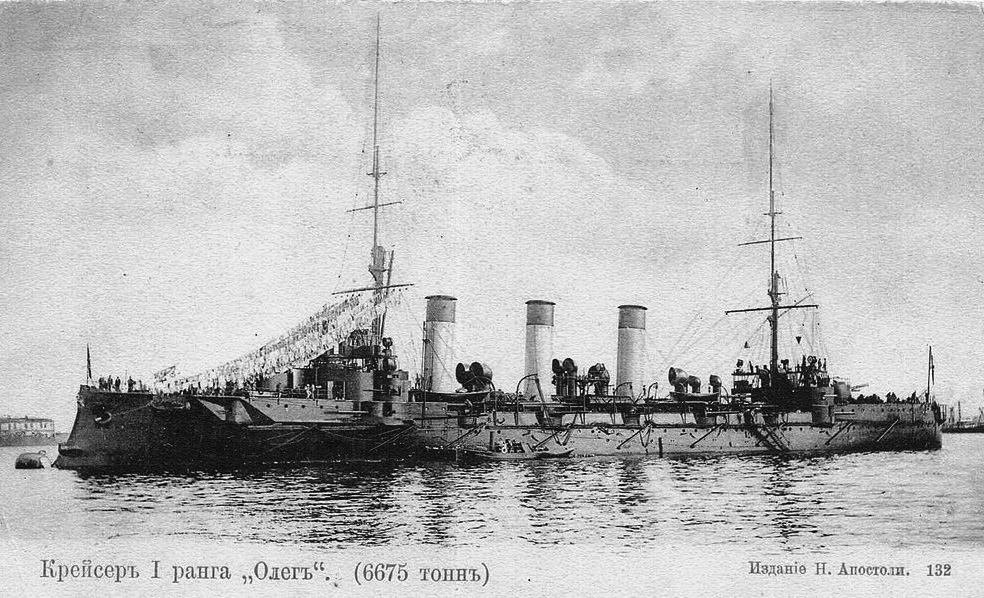
The cruiser “Oleg” replaced the Vityaz badly damaged on slipway and later scrapped. She was built in New Admiralty in the same slip as Borodino and earned all the equipment destined to Vityaz. She was laid down on November 1, 1901 but officially on July 6, 1902 and construction was delayed by design changed, reachinbg 6,440 tons 14, launched on August 14, 1903 and intended for the Far East and started her trials on August 22, 1904, to Kronstadt, and then to October 1904, whe she showed only 20.6 knots before being sent to the far east in emergency.
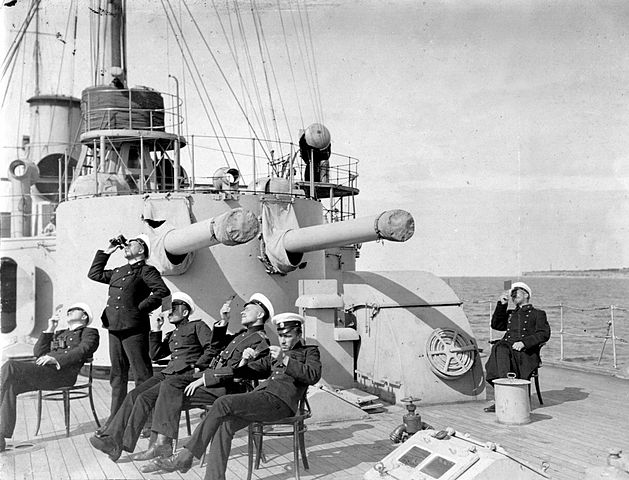
Under command of Admiral Oskar Enkvist, she was in the Second Pacific Squadron sailing around the world to relieve the blockade at Port Arthur. She fought at Tsushima on 15 May 1905, damaged, but managed to escape and took refuge like Aurora and Zhemchug in neutral Manila until the end of the war.
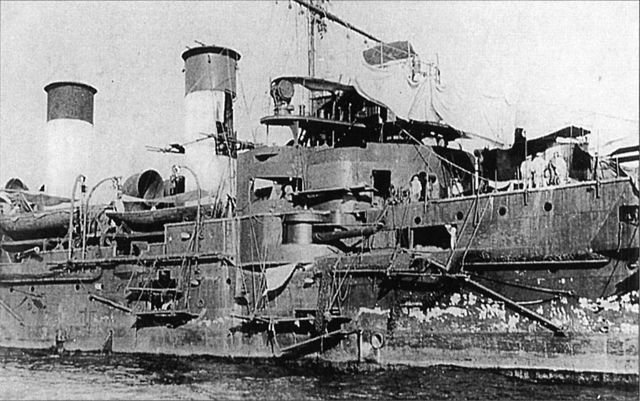
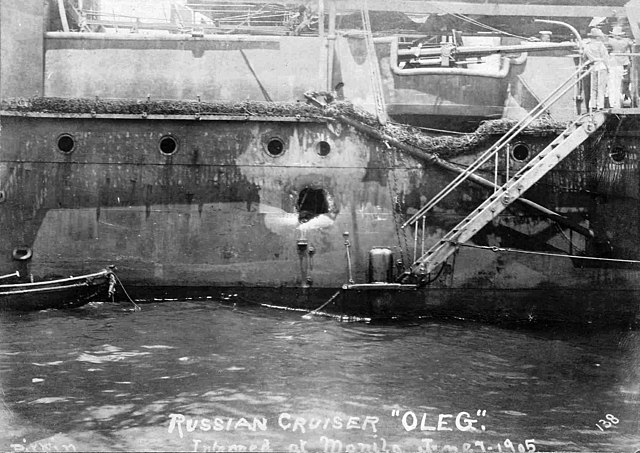
Back to the Baltic fleet, Oleg was refitted. On 27 September 1908 she ran aground off Kronstadt, refloated on 4 October, repaired in Kronstadt until December.
During World War I she was in the 1st Cruiser Brigade, Baltic Fleet, and by 26 August 1914 with Bogatyr she covered minelaying operations. Her own mines later sank the German light cruiser SMS Augsburg off Bornholm.
On 2 July 1915 she took part in the Battle of Åland Islands, driving SMS Albatross onto the beach.
In June 1916, she was part on the operation against Gotland.
In October 1917, her crew rallied the Bolshevik cause. The Treaty of Brest-Litovsk had her staying in Kronstadt and by November 1918 with Bogatyr she took part in the aborted invasion of Estonia. She was later torpedoed and sunk on the night of 17 June 1919 by the British CMB-4 (Captain Augustus Agar) in Kronstadt. She was scrapped in 1938.
 Kagul (Pamiat Merkuria)
Kagul (Pamiat Merkuria)
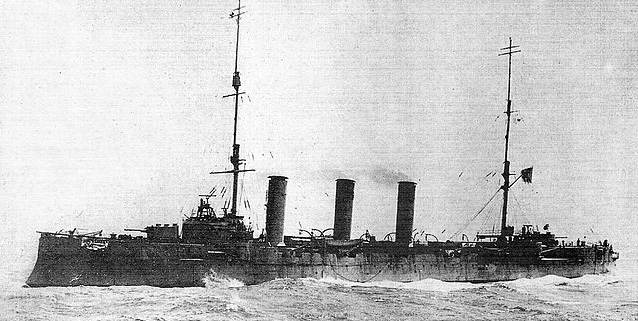
The cruiser Kagul was laid down on March 14, 1901 in No.7 basin at the Nikolaev Admiralty, laid down on August 23, 1901, launched on May 20, 1903 and started sea trials by 1905 until August 1907. She showed she can reach 24.75 knots, but had to wait for artillery until 1907. In March she was renamed “Pamiat Merkuria”. From October 6, 1913 to May 1, 1914, she was in overhaul in Sevastopoln Black sea fleet. Armament was upgraded with her 75-mm guns removed for four additional 152-mm guns.
During the First World War she took part in the same missiones as her sister Ochakov, and for 33 months, made 82 sorties, having 10 combat engagements. From September 1917 she was in Odessa.
In January 1915 Pamiat Merkuria and her sister Kagul twice encountered Breslau and the Ottoman protected cruiser Hamidiye, also spelled Hamidieh, but the Ottoman ships escaped both times without either side inflicting any damage.
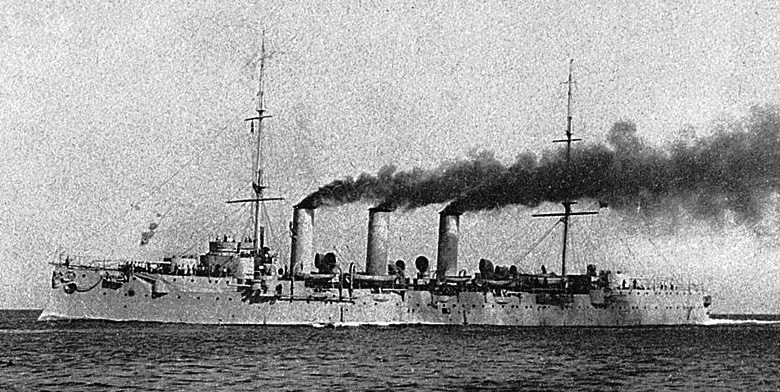
On 10 May 1915 she took part in the bombardment of Ottoman forts defending the Bosporus with sister ship Kagul, posted further out as pickets. Spotted by the battlecruiser Goeben/Yavuz, 115 miles (185 km) east of the Bosporus she was fired upon and chased off at full speed, dodging shells. ussian pre-dreadnoughts however stopped it by hitting Goeben three times so she broke off. She had fire herself many rounds.
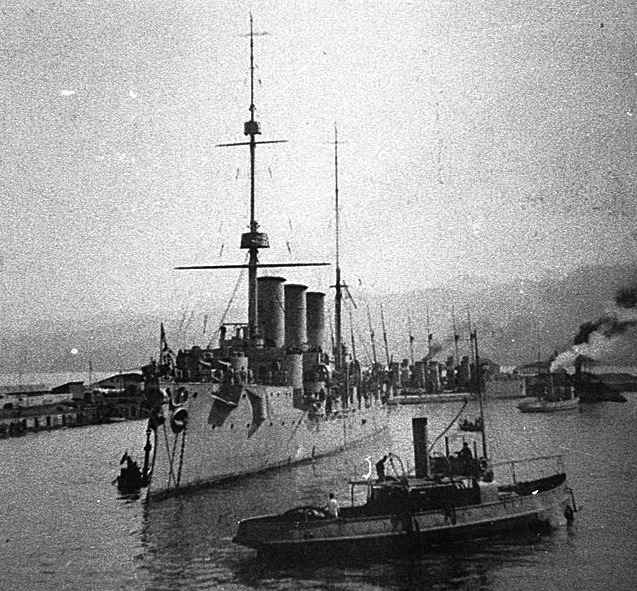
Kagul in Batumi 1916
She received new 130 mm guns in refit from December 1916 to April 1917. She was in Constanta on 1 November 1917, shelling the oil depot befire captured by the Germans. Later she fell in the hands of the Whites by November 1918. Her engines were wrecked by the British to prevent capture in April 1919 when Sevastopol fell. Later she was blown up by a mine when the Whites abandonede Crimea in 1920. Renamed Komintern, she was recommissioned in June 1923 after long repairs.
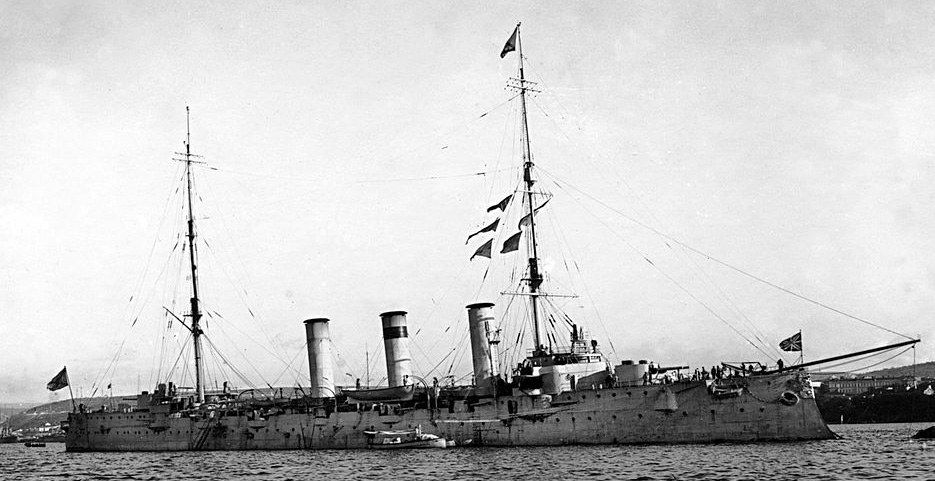
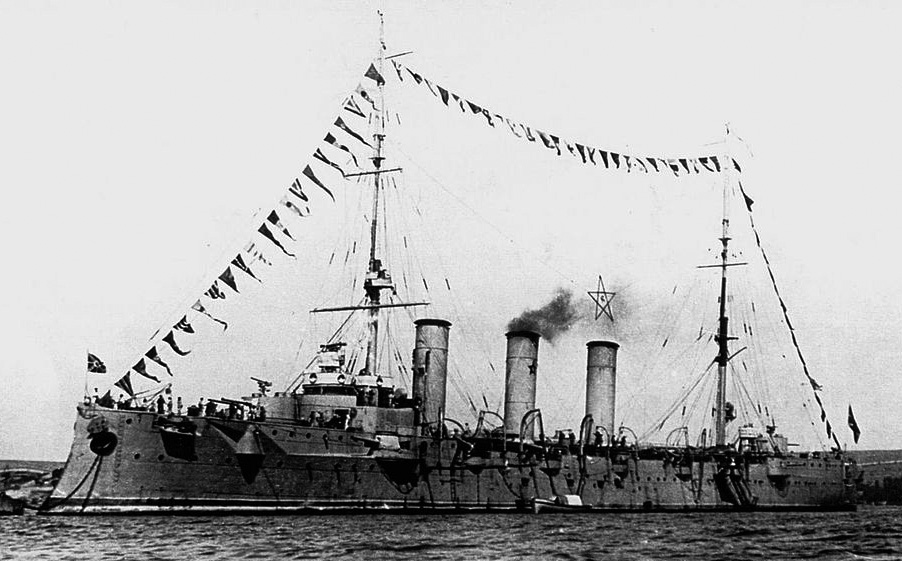
She was refitted in 1930 as a training cruiser (four boilers rmeoved for classrooms), speed 12 kts, four 75 mm/50 guns and torpedo tubes removed, 3 single 76,2 mm 34-K AA, 3 single 45 mm 21-K AA, 2 single 25 mm AA and five 12,7 mm HMGs. In 1941 she became a minelayer (195 mines). She served in the black sea fleet with Krasny Kavkaz, Chervona Ukraina and destroyerswhich sorteies to lay down off Sebastopol on 22 June. Komintern escorted by the DDs Nezamozhinsk and Shaumyan was used for coastal bombardment of Romanian positions with the Separate Coastal Army on 8 August 1941. In the siege of Odessa she escorted convoys to and from it. In the Crimean Campaign she delivered supplies to the 44th Army at Feodosiya and ferried troops and supplies to Sevastopol.
She was eventually badly damaged by the Luftwaffe on 11 March, and later at Novorossiysk by I. Gruppe, Kampfgeschwader 76 on 2 July 1942. She ended in Poti and this time near-sunk on 16 July 1942, disarmed in September 1942, and hulked. On 10 October she was refloated and towed to the mouth of the Khobi river and sunk as a breakwater.
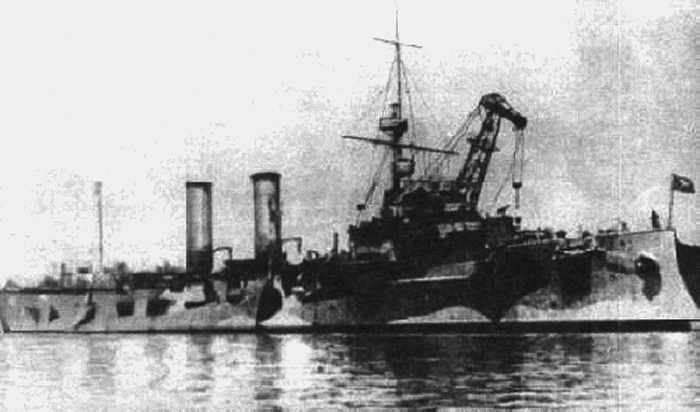
A camouflaged Komintern in 1942
 Ochakov
Ochakov
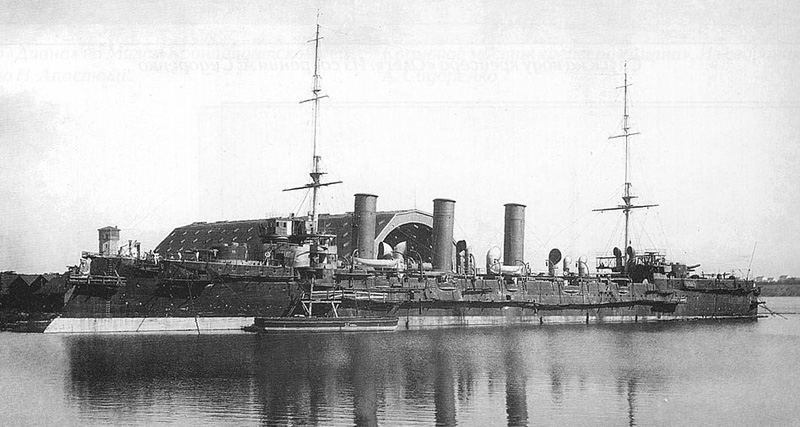
Cruiser “Ochakov” in completion.
Ochakov was laid down on February 27, 1901 on Lazarevsky Admiralty shipyard in Sevastopol. The official laying ceremony took place on August 13, 1901 and construction was carried out quickly se she was launched September 21, 1902. But many delays arose due to design changes and delays from suppliers and subcontractors. In September 1905, Ochakov started her sea trials and by November 13, 1905, the crew rebelled, taking an active part in the Sevastopol uprising. On November 14, 1905, Lieutenant P.P. Schmidt took the head of Ochakov and the following day an ultimatum was presented, rejected, after which the cruiser was fired upon by ships and coastal batteries loyal to the Tsar. She received 52 hits and caught fire but answered with just fire 5-6 shells. The fire lasted two days and was mastered poorly. In March 1906, Schmidt and three men from Ochakov (AI Gladkov, NG Antonenko, Quartermaster S. P. Priknik) were executed by a firing squad. The restoration of the cruiser took four years, so she was only ready by March 25, 1907 and like Potemkine, changed name for “Kagul”. She entered service on June 10, 1909, but improvements continued into 1910 until she was really serviceable.
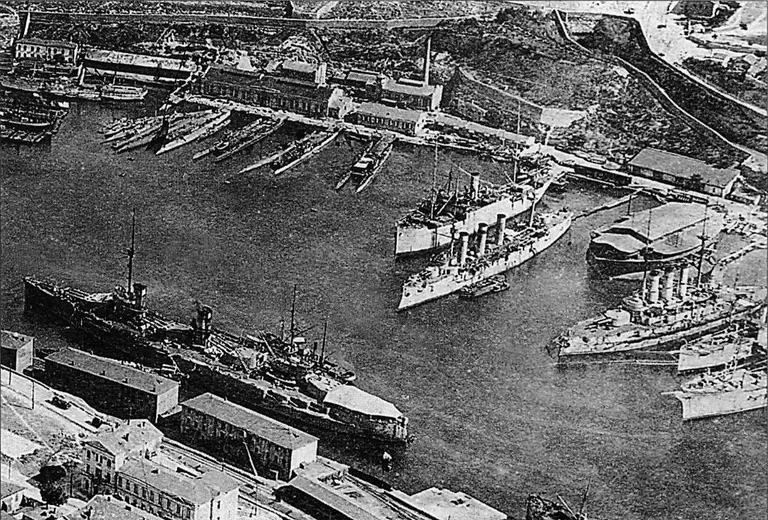
During WWI, Kagul was one of the pair of eyes of the Black Sea Fleet, looking for the Goeben and Breslau, and bombarded the Turkish coast or covered minelaying expeditions or laying mines themseves at several occasion, also capturing or sinking many Ottoman and Bulgarian coasters. On 15 March 1917, the Black Sea Fleet reupted in rebellion and the red flag was raised on Kagul’s mainmast. She was renamed Ochakov and was now commanded by a sailors committee.
After the treaty of Brest-Litovsk in March 1918 she was ceded to German control, captured in May and later passed ont to the British on 24 November, after the Armistice. She was passed on to the White Russians but had a very limited crew which concentrated on her main battery. She was renamed Kornilov but after after Denikin’s attack on Moscow failed his forces took refuge in the Black Sea and Wrangel took over it, until November 1920. They left Crimea and Kornilov was sailed out like the rest of the fleet to Constantinople and later Bizerte, French North Africa to be interned for four years then disarmed as France recougnised Soviet Union on 29 October 1924. She was transferred to the Soviets which decided after inspection to have her sold for BU in 1933.

General Assessment of the class
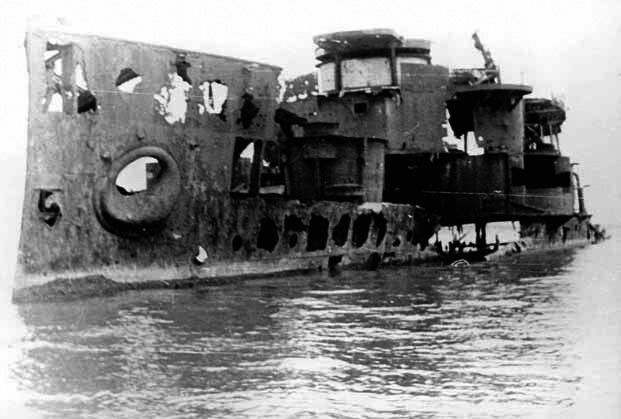
Komintern in 1942
As a result of the implementation of the 1898 program, the Russian fleet received many armored cruisers, resulting from three different projects. “Varyag”, “Askold” and the Bogatyr class. In tests they showed a comparable speed and Askold and Bogatyr proved to be very reliable ships in the service whereas Varyag constantly had machines and boilers issues. The nex “goddesses” (Pallada class) ended hopelessly inferior in all respects to the 1st rank cruisers of the 1898 program, and it was difficult to use them together.
Compared to artillery configuration, the Bogatyr class looked best on paper with 2/3 of the 152-mm guns in turrets, casemates, or turrets, all well protected from enemy fire unlike Varyag and Askold. In practice this was marred by many factors. First were the turrets, as shown above. Rate of fire dropped to the level of Varyag for a one-minute broadside salvo.
Second the shells used were all of the near-AP type with a very low explosive, so leaning more to SAP than HE. Added to their low weight and higher velocity they tend to just punch through and do little damage. Since the turrets were separated, artillery control was uneasy too. The 75 mm were also inneficient due to their location ad AP shells. In contrast the Japanese used their secondaries to rain down heavier HE shells in the Russian’s ships superstructure, doing far more damage.
In general, in terms of combat qualities, the Bogatyr class were indeed the best 1st rank armored ccruisers in the Russian fleet added to the fact they were of domestic construction. But they turned out to be overweight, slower, and not very reliable in practive. Their apparent superiority in armor protection remained significant though and they showed it at Tsushima with Oleg receiving more hits than Aurora, Varyag but with fewer losses in personnel.
Their size meant good seaworthiness which was especially important for the Pacific and they proved modular enough to be turned into high-speed minelayers later in their active life. They were also well built and had a solid appearance, always a nice sight to show the Russian flag.
Read More
Books
Brook, Peter (2000). “Armoured Cruiser vs. Armoured Cruiser: Ulsan 14 August 1904”. Antony Preston, Warship 2000–2001. Conway
Budzbon, Przemysław (1985). “Russia”. Conway’s All the World’s Fighting Ships 1906–1921.
Campbell, N. J. M. (1979). “Russia”. Chesneau, Roger & Kolesnik, Eugene M. (eds.). Conway’s All the World’s Fighting Ships 1860–1905.
Caruana, J. & Wetherhorn, Aryeh (1998). “Question 27/97: Vladivostok at War”. Warship International.
Frampton, Victor; Head, Michael; McLaughlin, Stephen & Spurgeon, H. L. (2003). “Russian Warships off Tokyo Bay”. Warship International.
McLaughlin, Stephen (1999). “From Ruirik to Ruirik: Russia’s Armoured Cruisers”. Antony Preston, Warship 1999–2000.
Watts, Anthony J. (1990). The Imperial Russian Navy. London: Arms and Armour.
Links
on battleships-cruisers.co.uk/
on uboat.net/
navypedia.org/
on ru.wikipedia.org
on en.wikipedia.org
on en.topwar.ru/
on laststandonzombieisland.com
3D
Videos
Gallery
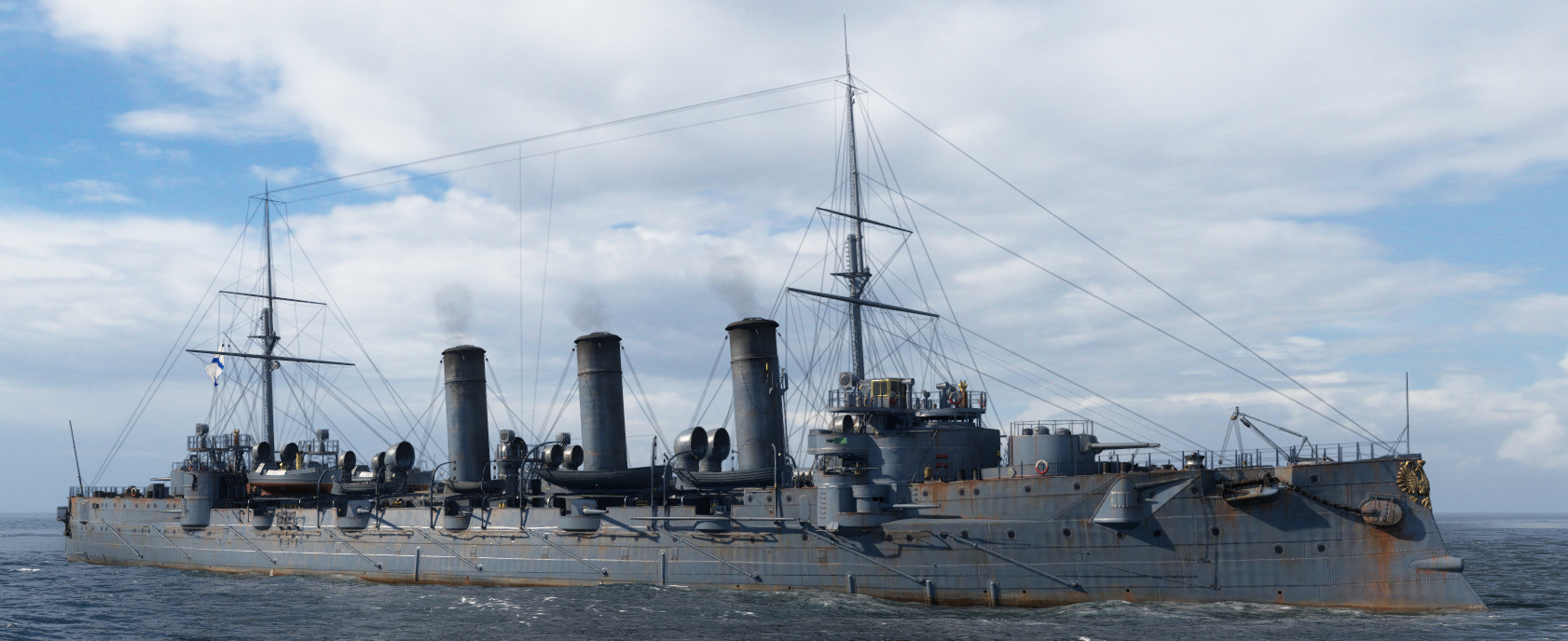

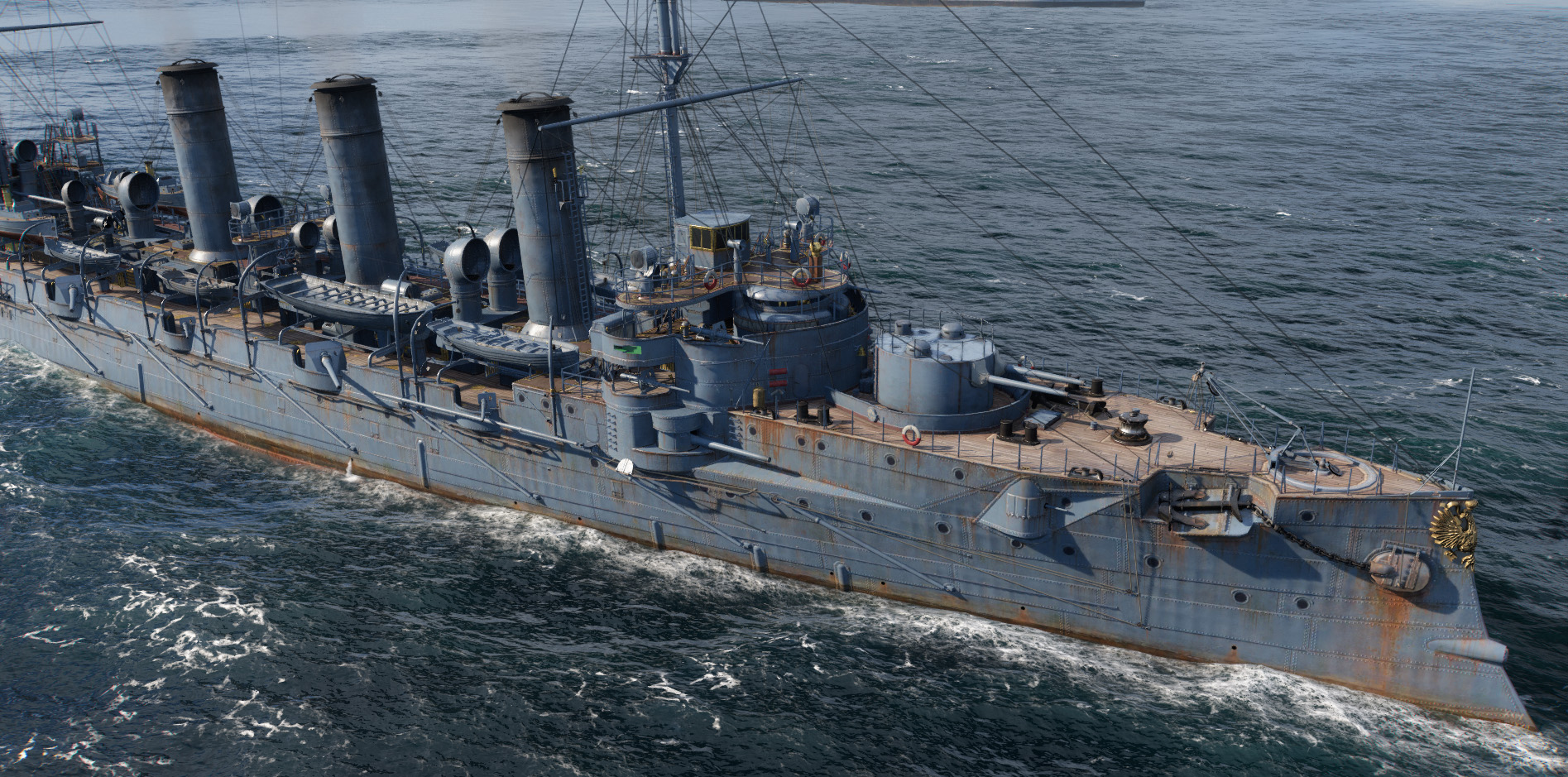
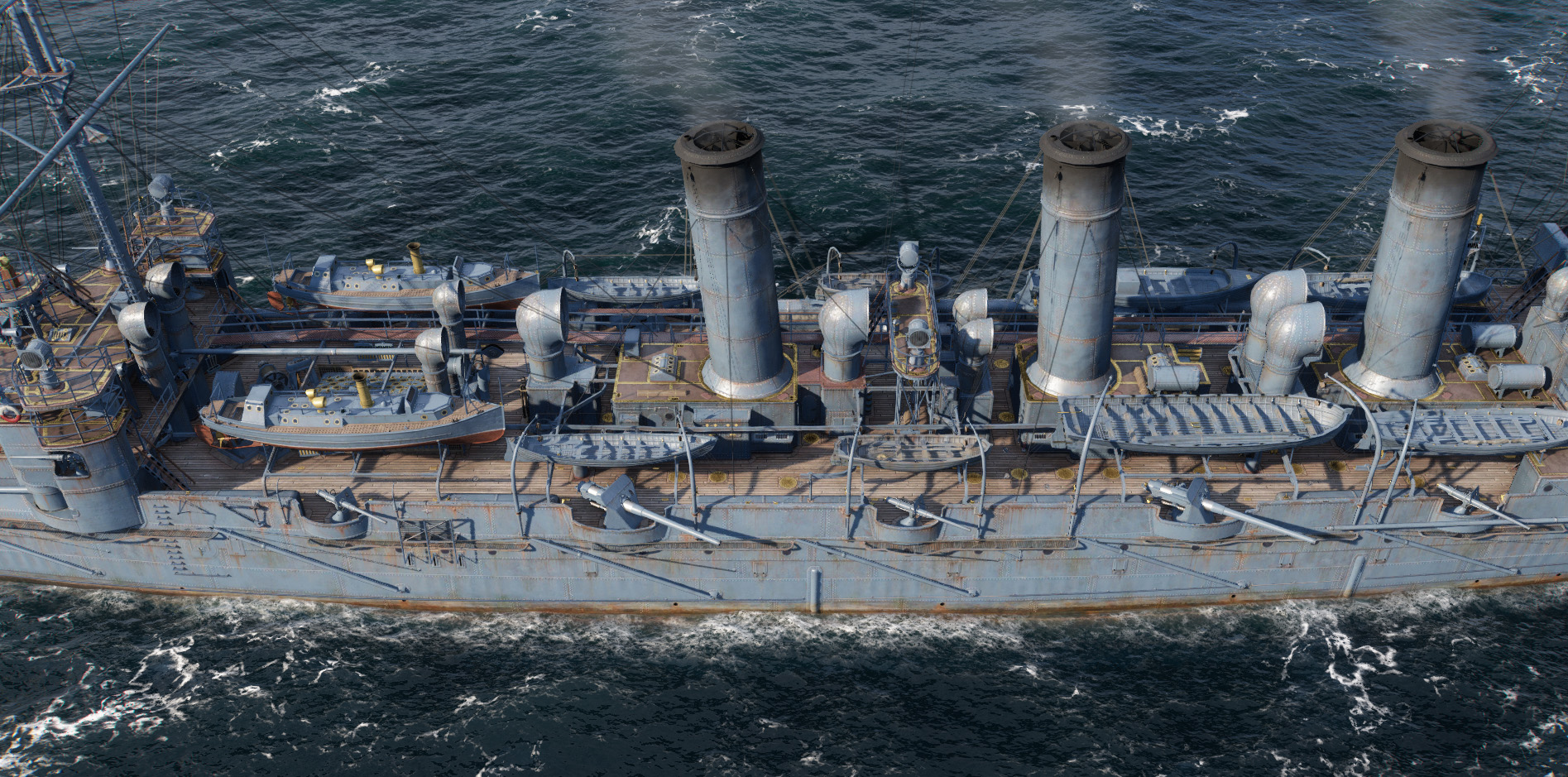
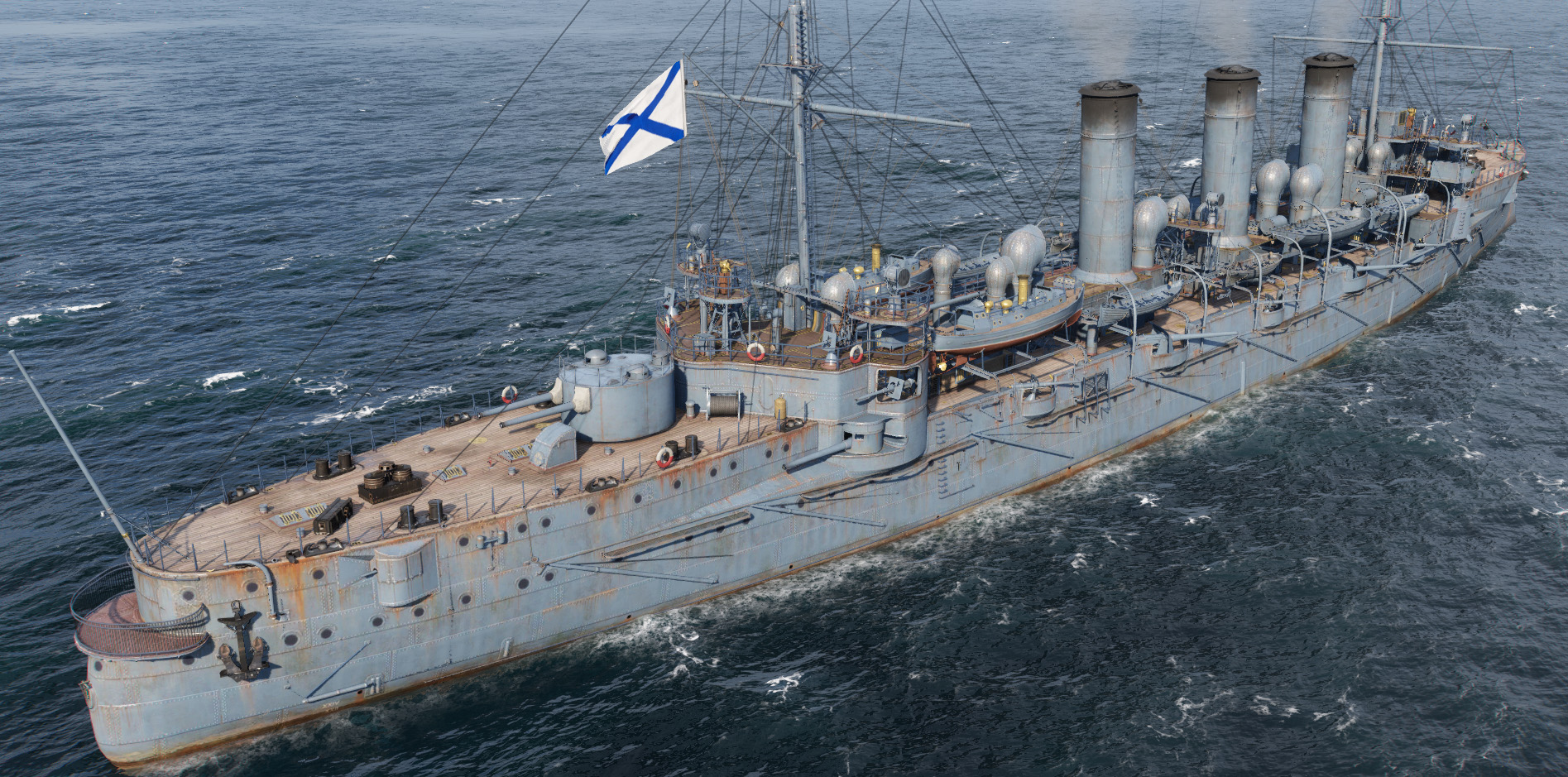
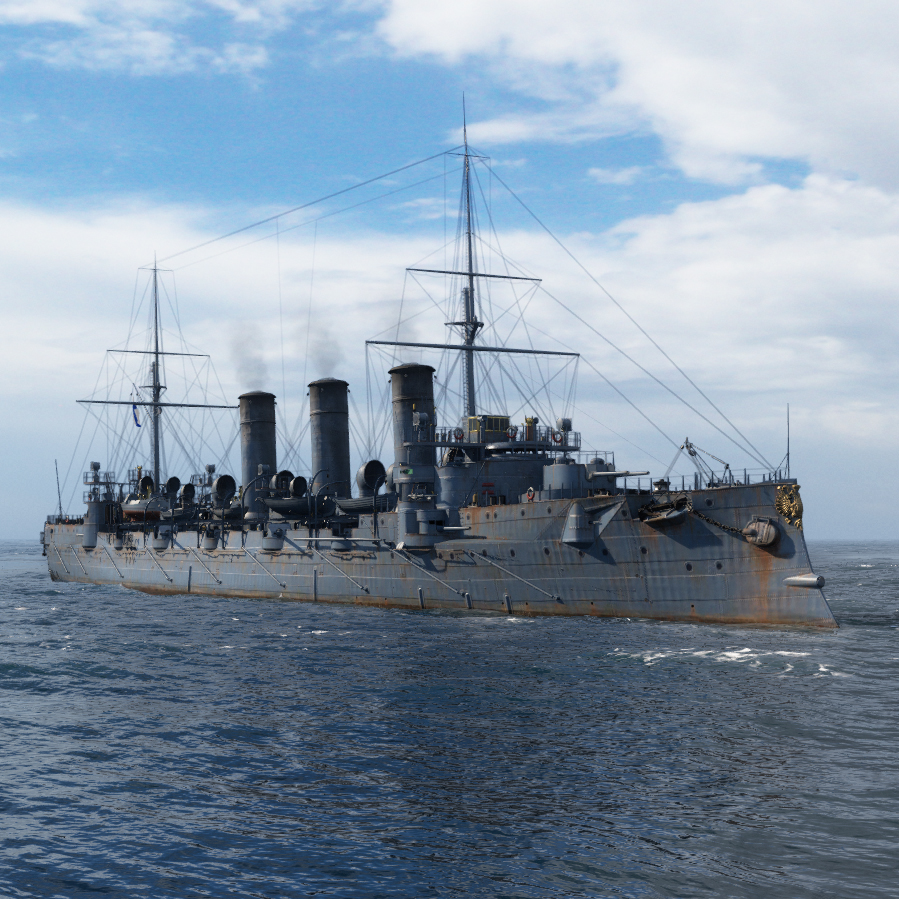
All are from World of Warships.


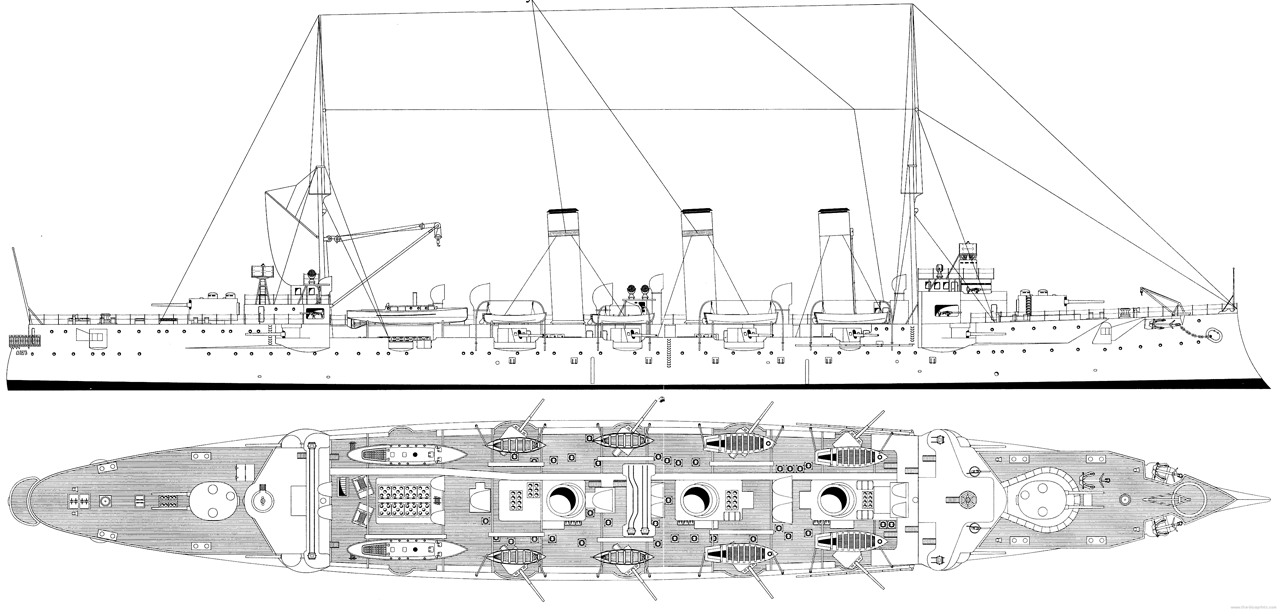
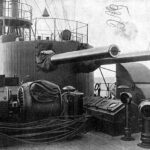
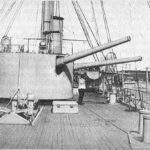
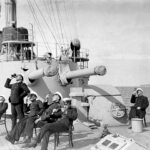
 Latest Facebook Entry -
Latest Facebook Entry -  X(Tweeter) Naval Encyclopedia's deck archive
X(Tweeter) Naval Encyclopedia's deck archive Instagram (@navalencyc)
Instagram (@navalencyc)





 Austrian Navy
Austrian Navy French Navy
French Navy Royal Navy
Royal Navy Armada Espanola
Armada Espanola K.u.K. Kriegsmarine
K.u.K. Kriegsmarine Dansk Marine
Dansk Marine Nautiko Hellenon
Nautiko Hellenon Koninklije Marine 1870
Koninklije Marine 1870 Marinha do Brasil
Marinha do Brasil Osmanlı Donanması
Osmanlı Donanması Marina Do Peru
Marina Do Peru Marinha do Portugal
Marinha do Portugal Regia Marina 1870
Regia Marina 1870 Nihhon Kaigun 1870
Nihhon Kaigun 1870 Preußische Marine 1870
Preußische Marine 1870 Russkiy Flot 1870
Russkiy Flot 1870 Svenska marinen
Svenska marinen Søværnet
Søværnet Union Navy
Union Navy Confederate Navy
Confederate Navy Armada de Argentina
Armada de Argentina Imperial Chinese Navy
Imperial Chinese Navy Marinha do Portugal
Marinha do Portugal Mexico
Mexico Kaiserliche Marine
Kaiserliche Marine 1898 US Navy
1898 US Navy Russkiy Flot
Russkiy Flot French Naval Aviation
French Naval Aviation Russian Naval Aviation
Russian Naval Aviation Sovietskiy Flot
Sovietskiy Flot Royal Canadian Navy
Royal Canadian Navy Royal Australian Navy
Royal Australian Navy RNZN Fleet
RNZN Fleet Chinese Navy 1937
Chinese Navy 1937 Kriegsmarine
Kriegsmarine Chilean Navy
Chilean Navy Danish Navy
Danish Navy Finnish Navy
Finnish Navy Hellenic Navy
Hellenic Navy Polish Navy
Polish Navy Romanian Navy
Romanian Navy Turkish Navy
Turkish Navy Royal Yugoslav Navy
Royal Yugoslav Navy Royal Thai Navy
Royal Thai Navy Minor Navies
Minor Navies Albania
Albania Austria
Austria Belgium
Belgium Columbia
Columbia Costa Rica
Costa Rica Cuba
Cuba Czechoslovakia
Czechoslovakia Dominican Republic
Dominican Republic Haiti
Haiti Hungary
Hungary Honduras
Honduras Estonia
Estonia Iceland
Iceland Eire
Eire Equador
Equador Iran
Iran Iraq
Iraq Latvia
Latvia Liberia
Liberia Lithuania
Lithuania Mandchukuo
Mandchukuo Morocco
Morocco Nicaragua
Nicaragua Persia
Persia San Salvador
San Salvador Sarawak
Sarawak Uruguay
Uruguay Venezuela
Venezuela Zanzibar
Zanzibar Warsaw Pact Navies
Warsaw Pact Navies Bulgaria
Bulgaria Hungary
Hungary

 Bundesmarine
Bundesmarine Dutch Navy
Dutch Navy Hellenic Navy
Hellenic Navy Marina Militare
Marina Militare Taiwanese Navy
Taiwanese Navy Chinese Navy
Chinese Navy Indian Navy
Indian Navy Indonesian Navy
Indonesian Navy JMSDF
JMSDF North Korean Navy
North Korean Navy Philippines Navy
Philippines Navy ROKN
ROKN IDF Navy
IDF Navy Royal New Zealand Navy
Royal New Zealand Navy Egyptian Navy
Egyptian Navy South African Navy
South African Navy

































 RN
RN
 Marine Nationale
Marine Nationale
 Soviet Navy
Soviet Navy
 dbodesign
dbodesign